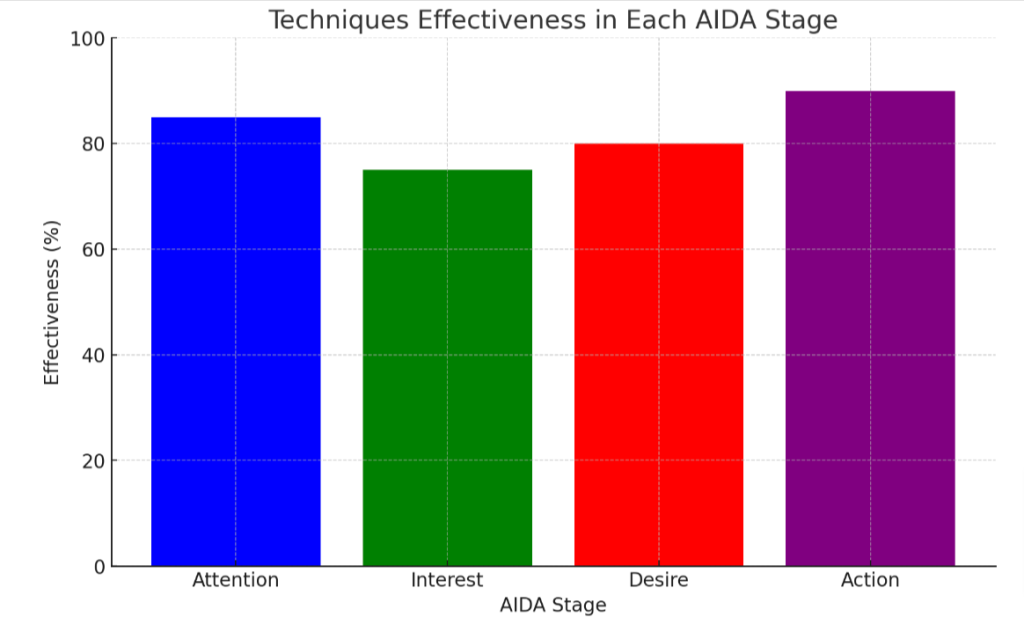Implementing AIDA: A Deep Dive into Effective Sales Copywriting Techniques
Do you struggle with sparking interest and igniting action in your sales copy? You’re not alone. Many businesses grapple with the challenge of creating compelling content that drives conversions.
This blog will introduce a proven method known as the AIDA model, an integral tool to craft impactful sales messages. Ready to transform your copywriting game? Let’s dive in!
Key Takeaways
- The AIDA Model is a marketing framework that breaks down the customer journey into four stages: Attention, Interest, Desire, and Action.
- To effectively use the AIDA model in sales copywriting, marketers must grab attention with compelling headlines, spark interest by highlighting product benefits, create desire by appealing to emotions and needs, and prompt action with clear calls-to-action.
- Using the AIDA formula involves understanding target audience needs, tailoring messages to address pain points, testing different variations of sales copy for optimization. By following these tips, businesses can leverage the power of the AIDA model to drive conversions and boost sales.
What is the AIDA Model?
The AIDA Model is a marketing framework that helps guide sales copywriting by breaking down the customer journey into four stages: Attention, Interest, Desire, and Action.
Definition and explanation
The AIDA Model stands as a classic marketing tool, illustrating the four stages customers often experience during their purchasing journey. The acronym represents ‘Attention’, ‘Interest’, ‘Desire’, and ‘Action’.
In simple terms, it focuses on grabbing customer attention first, stirring up their interest by emphasizing benefits, creating a desirable urge by associating products or services with the reader’s needs, finally leading them to perform the desired action – usually a purchase or sign-up.
This model aids marketers in crafting compelling sales copy that guides potential buyers from awareness stage to the point of transaction.
Origin and history
The AIDA model originated from marketing practices in the late 19th century. Advertising pioneer E. St. Elmo Lewis laid down its foundational principles back then, as a way to capture potential consumers’ attention and guide them towards purchasing decisions.
Lewis initially developed this groundbreaking framework for life insurance sales and it gained fame rapidly across different industries. The concept bloomed into a universally accepted strategy adopted by marketers worldwide, owing much of its success to its intuitive approach to customer journey mapping within the field of advertising and sales copywriting.
How to Use the AIDA Model in Sales Copywriting
To utilize the AIDA model in sales copywriting, marketers must first understand their target audience and craft messages that grab attention, pique interest, create desire, and prompt action.
By following this framework, businesses can guide potential customers through the buyer journey more effectively and increase conversion rates.
Applying the AIDA model to marketing
The AIDA model stands as an effective tool in the world of marketing. Here’s how you can use it:
- Grab Attention: Start with a headline that will immediately get your audience’s notice.
- Spark Interest: Next, create interest by providing intriguing details about your product or service.
- Ignite Desire: Help your customers visualize the benefits they would gain from what you’re offering. Use vivid language and compelling facts.
- Call to Action: Finally, initiate action by suggesting clear steps for your prospects to take next.
Tips for using AIDA in sales copy
To effectively use the AIDA model in your sales copy, consider these tips:
- Grab attention with a compelling headline or opening sentence.
- Create interest by highlighting the benefits and features of your product or service.
- Generate desire by appealing to the emotions and desires of your target audience.
- Clearly communicate a strong call-to-action that prompts readers to take the desired action.
- Use persuasive language and storytelling techniques to engage your audience.
- Keep your copy concise and easy to read, avoiding jargon or complex language.
- Test different variations of your copy to see which one resonates best with your audience.
- Understand your target market’s needs, wants, and pain points to tailor your message effectively.
The 4 Stages of the AIDA Model
The 4 Stages of the AIDA Model are Attention, Interest, Desire, and Action. Each stage plays a crucial role in guiding the consumer through the sales process and ultimately converting them into a customer.

Attention
To grab the attention of your audience, you need to create compelling sales copy that stands out. Use bold headlines, captivating images, or intriguing opening sentences to immediately pique their interest.
Make sure your message is clear and concise, addressing a problem or need that your target customers have. By using attention-grabbing techniques in your sales copywriting, you can draw people in and make them want to learn more about what you have to offer.
Remember, first impressions matter, so make it count!
Interest
Interest is the second stage of the AIDA model and plays a crucial role in sales copywriting. This is where you capture your audience’s attention and keep them engaged by highlighting the benefits and features of your product or service.
To create interest, focus on crafting messages that resonate with your target audience, using persuasive language and appealing to their desires and needs. By understanding your customer’s pain points and showcasing how your offering can solve their problems, you can pique their curiosity and make them more likely to continue reading or listening to your sales pitch.
Use eye-catching headlines, compelling storytelling techniques, testimonials, or demonstrations to spark curiosity and generate excitement about what you have to offer.
Desire
In the AIDA model of sales copywriting, the stage of “Desire” plays a crucial role in converting potential customers into actual buyers. This is where you create a strong desire for your product or service by highlighting its benefits and unique selling points.
Use persuasive language and storytelling techniques to engage your audience emotionally and tap into their needs and wants. By crafting compelling messages that evoke desire, you can motivate customers to take action and make a purchase.
Remember to focus on how your offering can improve their lives or solve their problems, as this will further enhance the desire they feel towards it.
Action
To effectively apply the AIDA model in sales copywriting, the final stage is taking action. This is where you invite your audience to make a purchase, sign up for a newsletter, or take any desired action that leads them closer to conversion.
In this stage, it’s crucial to clearly communicate the next steps and provide a simple and accessible way for your audience to act. Whether it’s through a call-to-action button on your website, an easily clickable link in an email, or a persuasive message in an advertisement, ensure that your audience feels motivated and compelled to take action based on their interest and desire.
By providing this clear path of action, you can increase conversions and drive results for your business.
In real-life examples of AIDA in action, successful advertising campaigns often include compelling calls-to-action that prompt consumers to buy products or avail services immediately.
Similarly, effective email copywriting strategically places persuasive messages urging recipients to click on links or make purchases. Additionally, websites with well-crafted sales copy guide visitors along the customer journey towards making a purchase by using attention-grabbing headlines and convincing content — all leading up to an irresistible call-to-action button prompting visitors to convert.
Examples of AIDA in Action
See how the AIDA model is applied in real-life advertising, email, and website copywriting. Master this technique and boost your sales conversions!
Advertising copywriting
Advertising copywriting plays a crucial role in implementing the AIDA model. By crafting messages that grab attention, spark interest, create desire, and prompt action, advertisers can effectively guide potential customers through the buying process.
In this stage of the AIDA model, copywriters need to understand their target audience and develop compelling advertisements that resonate with them. They employ persuasive writing techniques and use marketing psychology to tap into buyer behavior and influence consumer decision-making.
Through well-crafted advertising campaigns, businesses can leverage the power of the AIDA model to drive sales and achieve their marketing objectives.
Email copywriting
Email copywriting is a crucial aspect of utilizing the AIDA model in sales. When crafting email messages, it’s important to grab the reader’s attention right from the subject line.
Use compelling language and enticing offers to generate interest and make recipients want to learn more about your product or service. Create desire by highlighting the benefits and unique selling points, focusing on how your offering can solve their problems or improve their lives.
Finally, include a clear call-to-action that encourages readers to take immediate action, whether it’s making a purchase, signing up for a free trial, or subscribing to a newsletter.

Website copywriting
Website copywriting is a crucial aspect of utilizing the AIDA model in sales. It involves crafting persuasive messages that grab the attention of website visitors, spark their interest, create desire for the product or service being offered, and ultimately lead them to take action.
Effective website copywriting leverages engaging headlines, compelling calls-to-action, and clear benefits to guide visitors through the customer journey and drive conversions. By understanding buyer behavior and employing persuasive writing techniques within websites, businesses can optimize their marketing communication and increase sales.
Key tips for using the AIDA formula.
Using the AIDA formula effectively requires careful consideration and strategic implementation. Here are some key tips for making the most of this powerful marketing tool:
- Grab attention with a compelling headline or opening statement.
- Create interest by highlighting the benefits and unique features of your product or service.
- Build desire by appealing to your audience’s emotions, showcasing success stories, or offering special incentives.
- Encourage action by providing clear instructions and making it easy for potential customers to take the next step.
- Keep your messaging concise and focused to maintain reader engagement.
- Use persuasive language that resonates with your target audience.
- Tailor your copy to address specific pain points and challenges that your audience may be experiencing.
- Test different variations of your sales copy to optimize its performance.
- Continuously refine and improve your messaging based on feedback and results.
Conclusion
In conclusion, understanding the AIDA model is crucial for effective sales copywriting. By capturing attention, generating interest, creating desire, and prompting action, this framework helps convert potential customers into loyal buyers.
With its proven track record in advertising campaigns and customer journeys, mastering the AIDA model is an essential skill for any marketer or sales professional looking to craft persuasive messages and drive sales.

